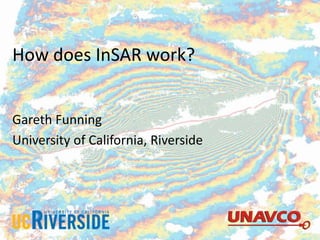Presentation on the background theory of InSAR
•Télécharger en tant que PPTX, PDF•
3 j'aime•1,844 vues
This document discusses how Interferometric Synthetic Aperture Radar (InSAR) works to measure ground deformation. It explains that InSAR uses the phase difference between two SAR images of the same area taken at different times to detect millimeter-scale changes in the distance to ground targets. It provides examples of how InSAR has been used to measure subsidence from earthquakes and other natural hazards. The document also notes some limitations of InSAR related to decorrelation from changes on the ground surface and in the atmosphere between image acquisitions.
Signaler
Partager
Signaler
Partager

Recommandé
Recommandé
Contenu connexe
Tendances
Tendances (20)
hyperspectral remote sensing and its geological applications

hyperspectral remote sensing and its geological applications
Urban Landuse/ Landcover change analysis using Remote Sensing and GIS

Urban Landuse/ Landcover change analysis using Remote Sensing and GIS
Sources of errors in GNSS measurements and dilution of precision (DOP) parame...

Sources of errors in GNSS measurements and dilution of precision (DOP) parame...
Understanding Coordinate Systems and Projections for ArcGIS

Understanding Coordinate Systems and Projections for ArcGIS
Similaire à Presentation on the background theory of InSAR
Similaire à Presentation on the background theory of InSAR (20)
Remote sensing Techniques Dr. Ange Felix NSANZIYERA

Remote sensing Techniques Dr. Ange Felix NSANZIYERA
2018-11-29 Theory and applications of Synthetic Aperture Radar

2018-11-29 Theory and applications of Synthetic Aperture Radar
WE4.L10.5: ADVANCES IN NIGHTTIME SATELLITE REMOTE SENSING CAPABILITIES VIA TH...

WE4.L10.5: ADVANCES IN NIGHTTIME SATELLITE REMOTE SENSING CAPABILITIES VIA TH...
Mars Geophysical Lander Proposal Authorization Review

Mars Geophysical Lander Proposal Authorization Review
WE3.L10.4: KIYO TOMIYASU, CO-SEISMIC SLIP AND THE KRAFLA VOLCANO: REFLECTIONS...

WE3.L10.4: KIYO TOMIYASU, CO-SEISMIC SLIP AND THE KRAFLA VOLCANO: REFLECTIONS...
Plus de SERC at Carleton College
Plus de SERC at Carleton College (20)
Cretaceous Coatlines and Modern Voting Patterns Presentation

Cretaceous Coatlines and Modern Voting Patterns Presentation
Presentation: Unit 1 Introduction to the hydrological cycle

Presentation: Unit 1 Introduction to the hydrological cycle
Presentation: Unit 2 Measuring Groundwater Background Information

Presentation: Unit 2 Measuring Groundwater Background Information
Presentation on the background theory of InSAR
- 1. How does InSAR work? Gareth Funning University of California, Riverside
- 2. Outline • Basics of SAR and InSAR • Application to earthquakes, and other examples • Limitations • The future
- 3. InSAR Interferometric Synthetic Aperture Radar pretend you have a big radar antenna use wave interference emit microwaves, measure echoes
- 4. SAR: how it works 1. Satellite emits radar pulse 2. Radar is backscattered 3. Amplitude and phase of echo recorded at the satellite
- 7. flight direction synthetic aperture (5 km instead of 10 m!) resolution 20 m instead of 5 km!
- 8. • SAR imaging uses amplitude (intensity) of backscattered echoes • Radar sees through clouds—all- weather imaging is possible • Don’t need illumination by the Sun— can image day and night • Surface roughness and slopes control the strength of the backscatter • Applications: ship tracks, ice tracking, oil slicks, land-use changes, planetary JPL
- 9. Kilauea caldera, Hawaii JPL Slopes facing toward satellite have bright backscatter Slopes facing away from satellite show dark backscatter and/or shadowing Flightdirection Look direction
- 10. Kilauea caldera, Hawaii JPL Areas of vegetation are “rough” and have bright backscatter Sedimentary drainages are comparatively smooth and have less backscatter
- 11. What about the phase? ~780 km ~6 cm Phase is a function of the distance from the satellite to the ground. ERS-1
- 12. Pass 1 Pass 2 InSAR: How it works
- 13. Pass 1: pre-movement Pass 2: post-movement phase shift due to ground motion phase=1 phase=2 InSAR: How it works
- 14. phase shift varies with distance from the fault InSAR: How it works
- 15. Image A - 12 August 1999 Image B - 16 September 1999 Interferogram = Phase A - Phase B Remove phase from topography satellite positions earth curvature Tim Wright amplitude phase
- 16. (0) 0 mm range change (-1) 28 mm range decrease (-2) 57 mm range decrease (-10) 283 mm range decrease (-20) 567 mm range decrease 17 August 1999, Izmit earthquake (Turkey) Tim Wright
- 17. A’ A 17 August 1999, Izmit earthquake (Turkey) Tim Wright
- 18. 10 km 2008 Wells, Nevada Each cycle of blue => yellow => red = 28 mm of displacement (half of the radar wavelength) away from the satellite
- 19. data model data – model Weston et al., 2012 Strike: 172° Dip: 38° Rake: –95° Mw: 6.06
- 21. 50 km Original unwrapped data Downsampling Optimization Slip model -1.3 1.3 Disp (m) 0
- 22. Schmidt and Burgmann (2003) Pritchard and Simons (2004) Wdowinski et al (2006)
- 23. Los Angeles time span = 1 day
- 24. July 1992–March 1993 February 1993–March 1993 Snow!Atmosphere!
- 25. Decorrelation • Changes in radar scattering properties of pixels • Vegetation, snow, flooding, the passing of time… • Longer radar wavelengths less susceptible Atmospheric “noise” • Refraction of microwaves by water vapor • “Static” part can resemble topography • “Turbulent” part can resemble deformation
- 26. Sentinel 12 (and then 6) day repeat in same orbit mean post event wait => 3 days ascending + descending => mean wait < 3 days SENTINEL-1A and -1B European Space Agency Launch Q2 2014, 2016
- 27. ALOS-2 by Japanese Aerospace Exploration Agency 14-day repeat in same orbit 23 cm wavelength – less decorrelation Launched Summer 2014